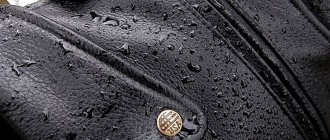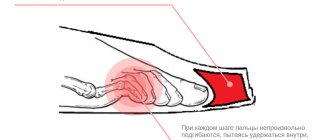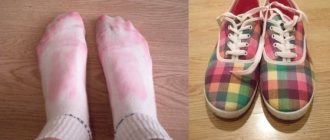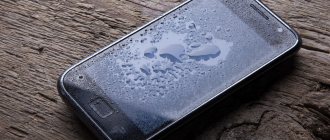One of the basic rules for ridding this item of dirt is to select those cleaning agents and products that have an exceptionally light, milky or transparent color. This is due to the fact that compositions or products with dark shades can spoil the white tone of the product. Therefore, it is not recommended to clean stains with coffee powder, colored products or strong chemicals.
The main rules for cleaning white leather products:
- White leather should not be soaked in water . It is best to clean the product more often, but without using a washing machine or prolonged soaking;
- before using any cleaning composition for the first time, it is advisable to conduct a trial experiment on an inconspicuous area , making sure that the item will not change its color;
- Every time after wearing this item, it is recommended to remove accumulated dust using a soft, damp cloth moistened with plain water;
- Before starting the cleansing procedure, it is recommended to remove all items from the pockets and fasten the existing locks and zippers;
- Wipe the product thoroughly with a soft sponge or brush;
- cleansers must be applied carefully, using smooth circular movements , trying to avoid strong friction so as not to damage the material;
- It is best to dry the item at room temperature, away from heating devices and heaters.
You should try to avoid excessive wetting of the skin, since the material, after being oversaturated with moisture, can lose its shape, become rough and inelastic.
It is recommended to clean white leather items immediately after getting dust or dirt, without waiting for the stain to be deeply absorbed.
Periodically cleaning leather jackets from small stains and dust
Frequently cleaning products made from snow-white leather or light-colored materials can lead to rapid wear and tear of your favorite item. Proper care of leather clothing, shoes, bags, and furniture can prevent the need for further washing. To do this, you must adhere to some recommendations and rules:
- New wardrobe items or furniture should be immediately treated with a special cream for white leather or a wax-based water-repellent impregnation. The procedure must be repeated at least once a week. This will help the natural material retain its elasticity, natural shine and color.
- After coming home, taking off your favorite leather clothes or shoes, you should clean them of dust. To do this, use a soft cloth soaked in warm water.
- Leather items should be stored in dry places that are frequently ventilated. It is impossible to cover such products with polyethylene.
- After each cleaning, light leather products are coated with special creams and wiped with egg white or glycerin. This will give things a unique shine and softness.
- If wet cleaning has been done, the item must be hung on a hanger with hangers. It must be strong enough to support the weight of the leather jacket. Thanks to this, the product will dry evenly and will not be deformed.
- To prevent a leather item from becoming wrinkled or shrinking, the room in which clothes or furniture will dry must be thoroughly ventilated before cleaning.
- Before cleaning, it is recommended to wipe the product with a damp cloth to remove dust.
- To wash the skin, you do not need to rub the surface of the material too much. Movements should be smooth, circular, and careful so that scratches do not form on the product. To do this, use only soft sponges, napkins, and rags.
If you follow these simple rules, every housewife will be able to maintain the fat balance of natural leather, preserve the initial paint job, get rid of dirt, and give your favorite item a second life.
To avoid damage, cleaning a leather jacket is carried out carefully, so it is better to entrust this task to specialists. But you will have to pay a tidy sum for their services. If you still want to skip dry cleaning and do everything yourself, pay attention to the following tips:
- If the jacket gets wet from snow or rain, it does not need to be put on and cleaned, as the product may stretch. Therefore, first it is blotted with a towel and dried at home at the temperature of the living room;
- Removing a fresh stain is much easier and more effective, so dirt needs to be removed quickly;
- The leather should not be ironed, but the lining should be ironed using a warm iron through gauze folded in several layers;
- Washing a leather jacket is not recommended (either in a machine or by hand), and rubbing it with force is also not recommended. Delicate washing is possible if there is a special symbol on the tag;
- The surface can be damaged by aggressive cleaning substances (gasoline and other solvents), so if you want to try cleaning your jacket with them, first test their effect on a small piece in an inconspicuous place;
- After wet cleaning, the item of clothing is wiped dry with a soft dry cloth and lubricated with castor oil or cream (vaseline) to avoid deformation and cracks;
- The cleaning agent is selected depending on the degree of contamination of the item and its type.
- You can get rid of dirt and dust by regularly wiping the product with a soft sponge moistened with soapy water or warm water. For a good effect, it is recommended to add 20-25 drops of ammonia (per half a liter of liquid). Next, the remaining soap solution is washed off with water, the surface of the wardrobe item is wiped dry and lubricated with cream;
- Thin and soft leather is cleaned with a dry rag or wiped with milk, then blotted with a napkin and lubricated with warm glycerin.
We clean and lubricate a heavily soiled product using special factory-made impregnations and creams that can give the material water-repellent properties, brightness, softness and shine. You can also use proven folk methods:
- You can clean the collar of a leather jacket (if it is shiny), cuffs, and small greasy spots if you use any of the following products: a cotton pad with lukewarm glycerin, damp baking soda, dishwashing liquid, makeup remover milk;
- Large or old grease stains can be cleaned with a rag soaked in vinegar, turpentine, gasoline or alcohol;
- Turpentine, gasoline, acetone, and white spirit will help get rid of paint or mold on clothes. But this must be done with caution, having first checked how the skin will react to these aggressive substances. After processing, a dark jacket is rubbed with orange peel, a light jacket with lemon peel, then dried and lubricated with glycerin;
- Thin leather items cannot be cleaned with gasoline. Grease stains are removed with talc, chalk or starch diluted in water. The gruel is applied to the contaminated area for 20-30 minutes, then brushed off with a clothes brush, and the surface is lubricated with castor oil.
You can clean a light leather jacket with a product that does not leave yellow spots or streaks. These include: lemon juice, cow's milk, talcum powder, egg white, dish detergent (without color).
- To make a white jacket look like new, it is treated with a napkin dipped in milk. This will give the skin shine and softness, brighten it;
- A yellowed white leather jacket is bleached with lemon juice, wiped and hung on hangers until dry;
- Lemon is not suitable for clothes of other colors, and it should not be used often either - the sour juice can harm the skin;
- Simple stains are removed from a light-colored item using egg white, which at the same time gives it shine. The protein is whipped, applied to the material until it dries, then washed off with warm water;
- To clean a white jacket from small grease stains, take soapy water with ammonia or a solution of dishwashing detergent;
- A mixture of talc with gasoline or turpentine will remove complex stains. The problem area is treated with a thick solution, glass is placed on it, and pressed with a press. After the mixture has dried, the material is cleaned with a soft brush, wiped with a damp sponge, and lubricated with glycerin.
We suggest you familiarize yourself with How and with what to clean dried stains from doors after repair - TPK-Master
If the surface of the product has lost its softness, has become rough and dry, and has also become dull and acquired microcracks, you can give it elasticity and color using aerosol paint for leather or using homemade methods.
To restore shine and softness, use:
- Beaten egg white;
- Warmed glycerin;
- Sliced onion;
- Fresh lemon cut;
- Coffee grounds wrapped in soft cloth;
- Orange peel.
After treatment, rub the surface of the product until it shines with a soft cloth, lubricate it with glycerin, colorless cream (for skin) or castor oil.
Taking good care of the jacket will yield results - it will warm and delight its owner for many years.
Ink stains
Traces of ballpoint and gel pens, felt-tip pens are cleaned from the skin with a cotton swab soaked in medical alcohol or warm glycerin.
You can remove ink stains with salt. Wet salt is poured onto the contaminated area and left for 1-2 days. Then the salt is removed, and the skin is treated with turpentine and lubricated with castor oil.
We recommend: CASTOR OIL for hair, eyelashes and skin
Important! Do not rub salt into the skin - hard crystals destroy it.
Precautionary measures
Before using any cleaner, try it on an inconspicuous piece of leather from the underside of the item. Here's how to check if a jacket is waterproof. Spray a little water from a spray bottle onto the skin from the inside out. If the wet surface has darkened, it is not recommended to use aqueous solutions to clean the jacket.
In any case, you can’t get the entire jacket too wet, because after drying it shrinks and can change structure and color. Based on this it follows that:
- Do not soak a leather jacket;
- You cannot use a washing machine;
- If the lining does not come off, then it must be washed very carefully.
At home, you can only influence certain areas. Usually the areas that get dirty the most are the cuffs, the area where they touch the neck, and the pockets. Sometimes stains from grease or ballpoint pens may appear, as well as splashes of dirt from walking.
We remove simple stains
- Soak a soft cloth in warm soapy water and try to clean dirty areas with it. You can use hair shampoo or liquid soap, and for greater effect, add a little ammonia if desired. Wipe with a cloth dampened in clean water, remove moisture with a paper towel or napkin. To soften the skin, lubricate it with castor oil. No castor oil? Look in your medicine cabinet for glycerin or petroleum jelly.
- Did you manage to clean your jacket? You can add shine to it with whipped egg whites. Rub them into the leather surface, and after a few minutes, go over the jacket with a damp cloth.
- If you have fresh milk in the refrigerator, try cleaning your jacket with it. Warm it up a little, moisten a cloth and wipe the product. Milk will remove simple stains, and the fat it contains will also soften the surface. If you were unable to clean it this way, dilute milk and turpentine in equal proportions. By the way, you can clean a very soft leather jacket this way. At the end of the procedure, lubricate its surface with colorless cream and rub with a soft cloth until shiny.
- You can also clean the product from minor stains with makeup remover milk. Squeeze onto a cotton pad and wipe away the dirt. Remove any remaining residue with a clean disc.
Eraser or solvent
You need to prepare a foamy soap solution. Some people use plain soap, but it dries out the skin, so you can use liquid hand soap or shampoo. With a cloth soaked in soapy water and wrung out, you can clean the dirty area, such as a collar or pockets.
To deal with greasy areas, add a little ammonia along with soap. The soap solution is washed off with plain water using a well-wrung out rag or napkin. Then the leather surface is wiped dry and at the last stage lubricated with Vaseline or castor oil. These two substances can be purchased at the pharmacy.
You can clean not only white, but also light-colored jackets of any shade with a soap solution, and instead of Vaseline and castor oil, I also use transparent cream.
Try cleaning a white or light leather surface using an eraser. In the case of suede products, this method works very well. You should only use a new, clean eraser so as not to stain your jacket even more.
Pen ink or other stubborn stains on white leather can be cleaned at home using nail polish remover or turpentine diluted in milk (1:1). Any solvent, be it pure gasoline, turpentine or acetone, must be used with extreme caution.
Before you clean with it, you need to make sure that it will not damage your skin. Run a swab soaked in solvent over the skin on the back of the lapel and wait a little. Only when you see no obvious changes can you carefully begin cleaning.
When home remedies are not at hand, a lotion for cleaning leather car seats can come to the rescue. It removes impurities very well, but is only applicable to smooth skin.
To make it easier for you to choose the right cleaning agent depending on the situation, we provide a comparison table.
| Means | Features of the action |
| Soapy water with ammonia | Removes minor stains well |
| Milk | Removes minor impurities and leaves skin soft |
| Lemon | Lightly whitens and cleans the jacket |
| Eraser | Cleans dirt from a light suede jacket |
| Clean gasoline, nail polish remover, turpentine | Cleans tough stains, but must be used with caution |
| Egg white | Adds shine |
| Castor oil, Vaseline, transparent cream | Soften the skin |
What to remember
- Remove stains as soon as possible . Fresh stains are much easier to remove.
- Cleanse your skin periodically . Use a simple damp cloth to remove dust.
- If folk remedies don’t help, try special ones . They usually cost from 500 rubles, so it’s easier to try cheap solutions first.
- When using formulations that dry out your skin, moisturize after cleansing . Any nourishing cream will do.
The video shows all the above steps clearly:
Milk or lemon
For simple stains, a white jacket can be cleaned with cow's milk. You need to pour some milk into a saucer. Then take a soft cloth, soak it in milk and wipe the outer surface of the jacket. Small impurities will be wiped off, and the skin itself will become a little softer thanks to the fats contained in the milk.
We suggest you read: How to remove smell from a jacket without washing
If there is a need to bleach and clean a slightly yellowed leather jacket at home, then use natural lemon, or rather, its juice. You need to squeeze the lemon into a cup, moisten a cotton swab with the juice and carefully, but with light movements, wipe your jacket with it.
It is often not worth using bleaching, since the protective layer can be irreparably damaged.
How to restore light skin color?
If the material on your jacket has become dull and has acquired a slightly different shade than it was when you purchased the item, you can also correct the situation. One of the following tools will help you with this.
Lemon juice
Lemon juice is one of the most effective means for whitening problem areas on fair skin. With its help, you can restore the original color of the product and eliminate yellowed areas. To do this you will need:
- Squeeze lemon juice into a small container.
- Dampen a soft cloth in it and rub the problem areas.
Important! It is worth wiping the skin without making much effort so as not to damage the surface of the clothing.
Cleaning and washing the lining
The dirty lining of the product is washed very carefully; it is important to avoid getting water on the skin. The ideal option would be to first tear off the lining, wash, dry, iron and sew. It is not always possible to cope well with such a labor-intensive task, so it is better to use dry cleaning services.
If the contamination is minor, you can clean the lining of a leather jacket in the following way:
- We turn the item inside out and hang it on hangers;
- Dissolve the washing powder in warm water;
- We carefully clean dirty areas using a clothes brush moistened with diluted powder;
- We wash off the powder composition from the fabric with a sponge moistened with a weak vinegar solution and blot the lining with a towel;
- We place your favorite item on a hanger and dry it without using heating objects, then ventilate it in the fresh air.
If there are greasy stains on the lining material, they are removed with vinegar, then the fabric needs to be washed. If both the lining and the outer layer of the product are dirty, you should first wash the lining and then clean the leather.
A few additional tips
There are special products for caring for leather jackets. They must be purchased along with the purchase of leather clothing and used regularly, then the product will retain its presentation for a long time. If we continue the conversation about inexpensive home methods, then we can add a few more tips:
- Rub a clean leather jacket with egg white, having previously beaten it. This gives outerwear a shine.
- Softness at home is ensured with the help of glycerin. They moisten the swab and wipe the surface. Since glycerin is transparent, this method is quite acceptable for a light jacket.
- When it becomes necessary to dry the product, it is put on a hanger with hangers. Drying is carried out at room temperature in a well-ventilated place.
- The hangers are selected in such a size and strength that they do not bend under the weight of outerwear. In this case, the jacket will dry evenly and will not change its shape.
If you see that the stain is complex and you can’t deal with it with improvised means, then take your favorite jacket to the dry cleaner.
How to remove an unpleasant smell from a jacket
Here's what you can do to clean your leather jacket to remove various unpleasant odors:
- To rid a piece of clothing of sweat that has been absorbed into the skin, fill the bathtub with hot water and pour in a glass of vinegar. We hang the item upside down on hangers over the water and leave it in the bathroom, the door of which is tightly closed. There will be no smell of sweat after hanging the item over steam for two hours;
- If the jacket is thin, excess moisture will not do it any good. Sprinkle bad-smelling areas with baking soda moistened with water. For an item soaked in tobacco smoke, the entire lining is sprinkled with wet soda, and after drying it is shaken off;
- Freshly ground coffee, which is sprinkled on the entire leather product, helps perfectly against the smell, and after a day the powder is shaken off;
- Orange zest also helps eliminate the unpleasant aroma of sweat, smoking or other stench. The outer part of the crusts is used to rub the skin;
- Oranges and coffee are not suitable for light-colored products; they can color the material.
In the collar area
First of all, to keep the collar as little as possible, you need to use neckerchiefs and, in cool weather, scarves. To clean the collar, use the same ingredients described above for greasy stains.
An effective way to clean a leather jacket in the collar area is:
- First, remove dirt from the collar with a swab moistened with alcohol.
- Then rub with lemon juice. An alternative to this can be orange peels.
- Then the surface of the gate is softened with glycerin.
In the event that there are concerns that the item may be damaged or traces of stains will remain, use the services of professionals - take the jacket to the dry cleaner.
Let us recall some rules for handling leather products:
- Try to let things dry if they become saturated with moisture. Do not hang them immediately in a closed closet.
- To prevent deformation of the product, do not hang it on hooks, but use hangers.
- Try to clean stains immediately after they form.
- Test the products you use to clean your products.
- In places of greatest contact with the skin, try to use cushioning materials and accessories (scarves around the neck, removable pads in the armpit area).
- Use leather care cosmetics, conditioners, and impregnations. Use those recommended for this type.
All this will give your leather jacket an attractive and updated look.
Folk and chemical cleaning products
Since ancient times, leather items have been considered very expensive. Furniture made from natural materials could only be seen in mansions and offices of large companies. Only celebrities or rich people wore leather clothing. Now anyone can buy such a product, but such things require special care.
To help remove blemishes from light skin, you can:
- milk;
- egg white;
- glycerol;
- lemon juice;
- ammonia or ethyl alcohol;
- dishwashing detergent;
- petrol;
- cosmetic milk;
- soap solution;
- shampoo;
- oxygen bleach;
- white pencil grater;
- perchlorethylene;
- onions and much more.
Despite the fact that such products very carefully care for white leather products, when applying them to the surface of clothing, shoes, accessories, and furniture, you should use a soft sponge or microfiber cloth so as not to damage the material.
It often happens that yellowness appears on leather clothing or furniture over time. Most often, contamination can be seen in areas of products that come into contact with various surfaces. For example, on cuffs, sleeves, pockets, lining, collar. The skin also turns yellow after exposure to rain.
Interior items can also be damaged by the paws of animals if the puppy does not wash them in time after a walk. There may be a million reasons for the appearance of dirt, but there are not many traditional methods for cleaning light skin at home.
Non-aggressive methods include:
- A solution that can be prepared using regular or liquid soap or dishwashing detergent. The advantage of the second option is that such soapy water does not dry out snow-white skin, which is famous for its softness. This product is suitable for cleaning surface dirt on leather shoes, outerwear, and furniture. It is enough to moisten a soft cloth in a soapy solution and wipe the dirty areas with it. First, you need to wring out the napkin thoroughly, because leather products do not like water. After cleaning, wipe the surface with a dry cloth.
- Milk that can cope with minor stains. You can use both packaged and homemade products. A soft cloth is moistened with milk, which is used to wipe dirty places, for example, on a jacket. This folk remedy will not only cleanse stains, but also give the product softness. The fats contained in the fermented milk product help soften the material.
- Lemon juice will help clear yellow skin from white skin. This product is considered a natural bleach. To cleanse yellow spots, squeeze the juice of half a lemon into a cup, soak gauze or a cotton pad in the solution and wipe the stained areas. The action should not be too diligent, so as not to get a lighter tone and not to erase the protective coating. It is enough to rub the stain with light circular movements.
- Grater for simple pencils. An eraser of the same color will help clean white or light suede leather. Only a new grater should be used.
- Special lotion for removing dirt from leather car seats. It will cope perfectly with stains of any origin and complexity. This product is only suitable for products made of smooth materials.
- Onions, which must first be peeled and cut into two halves. You need to take one part and carefully rub the stain on your shoes or clothes with a fresh cut. The advantage of the method is the absence of damage after cleaning, but the disadvantage is an unpleasant onion aroma (dissipates in about 2 days). After treating the surface of light leather, wipe it with a dry cloth.
- Egg white and milk. To prepare an effective remedy for dirt on the skin, take the white of one chicken egg and 100 ml of milk. The advantage of this method is its accessibility, because the housewife can find the necessary ingredients in the refrigerator.
- Baking soda is an ideal bleach for light leather shoes. It is prepared on the basis of soda and water (proportions 1:2). After treating the surface of a leather product, you need to let the product dry on its own.
- Cosmetic makeup remover milk will get rid of small stains of dirt and is suitable for cleaning the surface of products made of delicate materials.
All these cleaning methods can only help if there are pinpoint, easily removable stains on clothes, accessories, furniture and other light-colored leather products.
Aggressive or abrasive substances will help remove stubborn dirt and greasy stains from white skin. Special household chemicals, pure gasoline, nail polish remover and other products are perfect. They must be handled with extreme caution and applied using a small cotton pad or swab.
We suggest you familiarize yourself with How to wash fuel oil from a jacket at home
So, what aggressive substances can cope with serious stains on leather products:
- Toothpaste or powder - suitable for cleaning shoes, car interiors, and interior items with light leather inserts. To do this, you need to prepare the product itself and a clean toothbrush with soft bristles. It is necessary to rub dirty areas slowly, in a circular motion, without rushing. It must be remembered that toothpaste or powder contains abrasive particles that can damage the soft texture of leather upholstery or clothing.
- Oxygen bleach is a real panacea for stubborn stains and grease. Before using such a product, you must read the instructions and test the effectiveness of the chemical on an inconspicuous area of the product. If everything is fine, then you can start cleaning things using the prepared solution and a cotton swab. After completing the procedure, it is recommended to wipe the surface of light skin with a dry cloth or cloth.
- Nail polish remover is the best solution for removing ballpoint pen marks on white leather items. Acetone is applied with cotton wool to the contaminated area, then washed off with a damp cloth rinsed in warm water. To reduce the concentration of the substance, it can be diluted with cow's milk in a 1:1 ratio.
- Turpentine or gasoline is an effective remedy that can cope with traces of rust on white leather. The surface of the product should be treated with gloves and a soft sponge or cotton swab (it all depends on the size of the contamination). Talc will help reduce the concentration of turpentine, gasoline or any other solvent; it produces an excellent cleaning paste, which is similar in thickness to sour cream.
Leather wardrobe items treated with such aromatic products should be aired on the balcony after sunset so that direct sunlight does not fall on clothing. With furniture, everything is a little more complicated; the apartment or house will have to be ventilated for 3-4 days.
Removing grime
The collar, sleeves, pockets and fasteners of leather jackets get dirty faster, especially for men. When worn, there is constant contact with human skin, and it actively releases sweat and fat, leaving dirty marks on the collar.
What is recommended to properly clean the collar:
- Spread the leather jacket on something flat and hard so that the collar is as straight as possible.
- Take a soft rag or cotton pad and dip it in alcohol.
- Carefully treat the collar, especially the tips and folds (they are the most contaminated).
- Wipe the collar treated with an alcohol solution with lemon juice or orange zest to dissolve greasy stains and eliminate the greasy odor.
- Soften the top of the collar with glycerin.
- Hang the jacket on hangers and wait until the collar is completely dry.
Pockets, fasteners, sleeves are cleaned in the same way as the collar. The main thing is to maintain the neatness of your leather product by cleaning it regularly.
Removing difficult stains
Several types of stains are most common. The table below shows how to display them.
| Paint, mold | Remove contamination with solvent, gasoline or turpentine diluted with milk. Soften the surface of the jacket with castor oil, glycerin or leather cream. To eliminate the unpleasant odor, hang the product in a well-ventilated area, then lubricate it with lemon juice. |
| Ball pen | Moisten a cotton pad with alcohol and wipe the stained area. |
| Salt stains | Use regular vinegar for cleaning. |
| Blood | Several withdrawal methods: Immediately wash away the red stain using soap suds and cold water. Use hydrogen peroxide after first checking the reaction of the jacket's skin on a less noticeable area. Apply aspirin dissolved in water. |
Regular care
In order for a leather jacket to remain “like new” for a long time, you will have to take care of it regularly. It is enough to do this monthly or once every 3 weeks: monitor quickly contaminated areas (collar, fur, sleeves, pockets, fasteners) and wash them immediately.
- Prepare a regular soap solution with a couple of drops of ammonia.
- Take a soft flannel cloth or a non-hard sponge, soak it in the solution, carefully clean the leather jacket where the most dirt is, or better yet, apply it to the entire thing.
- Rinse the surface of the leather product with regular running water and wipe it dry without any extra effort.
- Lubricate cleaned, dried skin with castor oil or a special cream for leather surfaces.
In order not to spoil the appearance and quality of a leather jacket or leatherette jacket, it is recommended to carefully study the information about the care method on labels or tags, following the simple rules described above.
What not to do
Along with recommendations, there are also “contraindications”, which should never be done when it comes to cleaning light-colored leather items. Many housewives are mistaken in believing that they can speed up the drying process of clothes or shoes made of genuine leather by placing them on a radiator. This action can lead to drying out of the material and the appearance of cracks.
In such cases, it is better to use a soapy solution for cleaning. After completing the procedure, the item must be dried with a paper towel. If it comes to machine washing, then you should set the delicate mode without spinning.
Soft, light-colored skin requires special care. For cleaning or coating, you cannot use creams and sponges that are used for dark leather shoes and clothes. Snow-white shoes made of natural material cannot be stored next to colored items. This is fraught with tarnishing of an expensive product.
Cleaning white leather at home is not an easy task, but it is quick. It is enough to correctly determine the degree and type of contamination, select suitable folk or chemical remedies and thoroughly wash the traces with a soft sponge. All that remains is to dry and air things out, after which clean clothes can be worn outside again.











